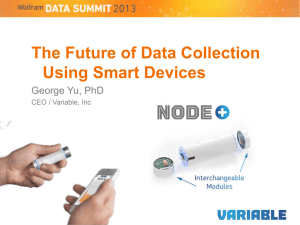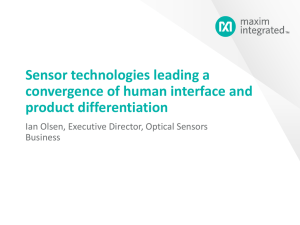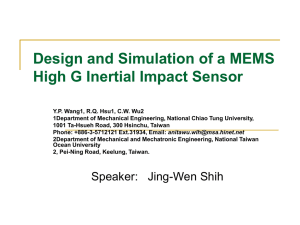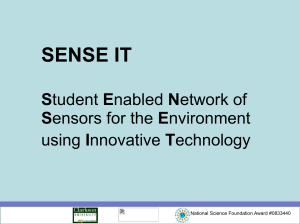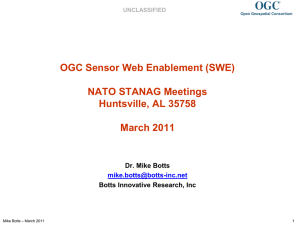Sensor Web Standards and the Internet of Things
advertisement
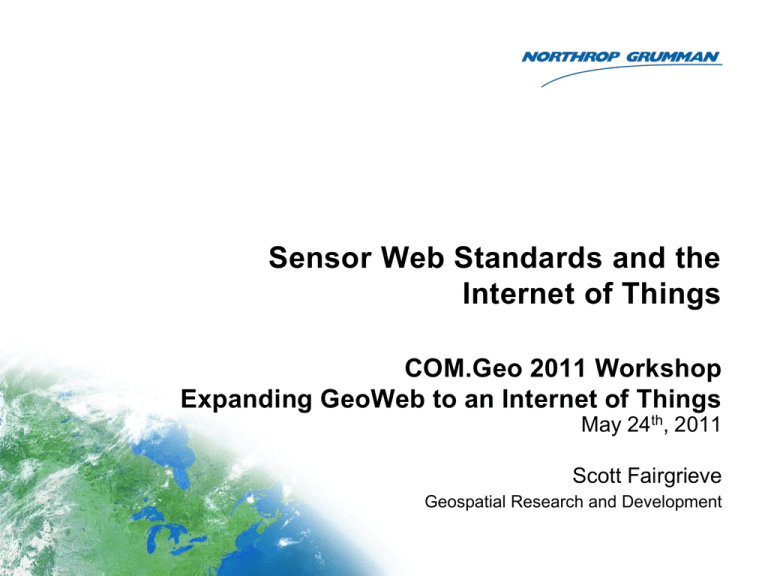
Sensor Web Standards and the Internet of Things COM.Geo 2011 Workshop Expanding GeoWeb to an Internet of Things May 24th, 2011 Scott Fairgrieve Geospatial Research and Development Internet of Things (IoT) Supporting Technologies/Research Areas* • Identification Technology • Architecture Technology • Communication Technology • Network Technology • Network Discovery • Software and Algorithms • Hardware • Data and Signal Processing Technology • Discovery and Search Engine Technologies • Relationship Network Management Technologies • Power and Energy Storage Technologies • Security and Privacy Technologies • Standardization *From: “Vision and Challenges for Realising the Internet of Things”, March 2010 http://www.internet-of-things-research.eu/pdf/IoT_Clusterbook_March_2010.pdf 2 The Role of Sensors in the IoT • Sensors are important for tagging, tracking, locating, and monitoring things, and for enabling things to be aware of the environment around them • Sensors are a key enabler of the IoT and a foundational technology for many IoT building blocks and related technologies (highlighted in red) Table From: “Vision and Challenges for Realising the Internet of Things”, March 2010 http://www.internet-of-things-research.eu/pdf/IoT_Clusterbook_March_2010.pdf 3 The Need for Sensor Standards • Sensors are already prevalent today, but they will become even more necessary and prevalent in IoT-enabled devices and applications – RFID readers, cameras, accelerometers, GPS, thermometers, etc. • Sensors are developed by a variety of manufacturers, using many different protocols and formats, making the interoperability and large scale sensor integration required by the IoT difficult without standards • Effective use of sensors to enable and drive the IoT requires standards for discovering sensors, retrieving sensor data, tasking sensors, and subscribing to and receiving sensor alerts The decentralised and heterogeneous nature of things and the entities with which they interact requires a scalable, flexible, open, layered, event-driven architecture of standards that minimises or eliminates any bias towards any single programming language, operating system, information transport mechanism or other technology and makes efficient use of available network connectivity and energy, where required.* *From: “Vision and Challenges for Realising the Internet of Things”, March 2010 http://www.internet-of-things-research.eu/pdf/IoT_Clusterbook_March_2010.pdf 4 Sensor Webs “… web accessible sensor networks and archived sensor data that can be discovered and accessed using standard protocols and application program interfaces (APIs)” From OGC 07-0165 - OGC Sensor Web Enablement: Overview and High Level Architecture 5 Open Geospatial Consortium (OGC) Sensor Web Enablement (SWE) Standards • Help to enable the vision of the Sensor Web by eliminating barriers to sensor interoperability • Include XML-based messaging formats and web service interfaces for discovering, accessing, and controlling all types of sensors • Include built-in support for location and a variety of coordinate reference systems that should address both outdoor and indoor location • Sensors, measured phenomena, geographic features, and other items are all identified using Uniform Resource Identifiers (URIs) • Built with the Semantic Web and shared vocabularies/ontologies in mind – Semantic interoperability is seen as a key building block of the IoT • The 1.0 versions have been around for a few years, with the 2.0 versions being adopted now. The 2.0 versions include: – Better support for asynchronous messaging – Improved consistency across standards • OGC has formed a Pub/Sub Standards Working Group (SWG) to address broader support for pub/sub technologies across its standards – 6 Should help with real-time /event-driven IoT use cases OGC SWE Standards 7 Encoding Description Sensor Model Language (SensorML) Describes and models processes, sensors, and systems of sensors Observations and Measurements (O & M) Format for encoding sensor observation data SWE Common A common set of data types for describing sensor data, used by SensorML and O & M Web Service Description Sensor Observation Service (SOS) Provides archived and near real-time access to sensors and their data. Sensors are described in SensorML and sensor data are described in O & M. Includes optional support for adding new sensors and publishing their observations. Sensor Planning Service (SPS) Provides access to controllable sensors and actuators and the means to task those sensors/actuators in a standard way. Sensor Alert Service (SAS) Provides the ability to subscribe to and receive sensor alerts in real-time. Utilizes Extensible Messaging and Presence Protocol (XMPP) for delivering alerts in real-time Sensor Event Service (SES) Provides Complex Event Processing (CEP) and filtering of sensor data streams Web Notification Service (WNS) Standardized asynchronous messaging/notification mechanism for receiving messages in many ways, including e-mail, Short Message Service (SMS), phone, etc. OGC GeoWeb Standards These standards complement the sensor web standards and provide geospatial context to sensor web information in terms of populating mapping applications with maps and feature data and can support sensor data processing and fusion (e.g. the WPS). 8 Encoding Description Keyhole Markup Language (KML) An OGC standard format for displaying geospatial data such as points, lines, polygons, and images in many mapping applications including Google Earth. Geography Markup Language (GML) An OGC standard format for describing geographic features like points, lines, and polygons. Web Service Description Catalog Service for the Web (CS/W) Provides OGC web service and object discovery (i.e. sensors and other geographic features) Web Map Service (WMS) Provides access to raster map data (i.e. static images) that can be used to generate a map background. Web Feature Service (WFS) Provides access to vector map data (i.e. points, lines, and polygons). Could provide access to location/information about things in the IoT, since these things would be classified as features. Web Coverage Service (WCS) Provides access to geographic coverage data (i.e. geographically distributed measurements) Web Processing Service (WPS) Provides a standard interface for discovering, describing, and executing geoprocesses. User Applications - The SWE-Enabled Home SensorML System - Thermometer(s) - Ice/Water Dispenser Switch - Door Switch - RFID Reader Sensor Observation Service (SOS) Sensor Planning Service (SPS) Sensor Alert Service (SAS) SOS Web Notification Service (WNS) SPS SAS SWE Client Smart Appliances SWE Smart Agents WNS 9 User Applications - The SWE-Enabled Home Sensor Observation Service (SOS) Where are my keys? RFID Reader SWE Client 10 Retrieve Inventory Data SOS User Applications - The Smart Store • In-Store Navigation – Help me find items on my shopping list – Direct me to each item I want using the shortest path • Utilizes multiple OGC GeoWeb and Sensor Web services as well as other services – Need to discover available inventory services – Find the location of items on my list in local store coordinates (makes use of sensors/services for monitoring inventory locations) – Show me a local store map (WMS, WFS, etc.) – Calculate the shortest path using my current location along with the locations of various items (WPS) 11 User Applications – Environmental Monitoring Supplemented with Citizen Scientists Sensor Observation Service (SOS) SOS Transactional SWE Client SWE Client SWE Client SWE Client SWE Client SWE SWE Smart SWE Smart Agents Smart Agents Agents SOS Official and Reference Environmental Sensors 12 Challenges • Scaling – Can/how do the SWE standards work in an IoT environment on a large scale – billions/trillions or more sensors/“things”? • Discovery – How do I find sensor services? How do I make my sensors discoverable? Is there a central catalog or set of catalogs or a search engine for the sensor web where I go to find services, or is there some peer-to-peer mechanism where sensors/services notify me of their availability? • Performance – Moving towards event-driven, publish/subscribe, CEP mechanisms to optimize the flow of information information can be stored as needed, filtered and sent to the appropriate recipients/applications • Standards Harmonization – Multiple sensor and IoT standards need to be harmonized in order to realize interoperability across sensor systems • Big Data – Sensors and the IoT add to the growing amount of monitoring data that is available to a wide range of users. How do we effectively analyze all of this data and ensure that meaningful and relevant data and decisions are made? 13 Questions 14 Contact Information • Scott Fairgrieve – Email: scott.fairgrieve@ngc.com – Phone: 703-227-1549 • Stefan Falke – Email: stefan.falke@ngc.com – Phone: 314-331-6215 15



